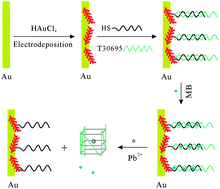
Electrochemical Sensing Using Target-Induced Strand Release
The toxic, bioaccumulative, and non-biodegradable effects of heavy metals pose a severe environmental concern. Hence, monitoring toxic metals such as lead requires effective detection methods. Bo Tang and colleagues from the Shandong Normal University, China, have developed the latest electrochemical detection strategy, which is based on the target-induced strand release method. In their design, the lead-binding DNA aptamer forms a duplex with a complementary DNA sequence that is immobilized to an electrode surface. In this state, methylene blue redox indicators are able to intercalate along the duplex structure, and provide a readable electrochemical signal. However, in the presence of lead, the metal ions bind specifically to the aptamer, which allows release of the lead-aptamer complex into solution. The subsequent release of methylene blue molecules away from the electrode surface leads to a measurable decrease in signal to signify lead detection.
Find out more details by accessing the link below:
A selective amperometric sensing platform for lead based on target-induced strand release
Feng Li, Limin Yang, Mingqin Chen, Peng Li and Bo Tang
Analyst, 2013, 138, 461-466
DOI: 10.1039/C2AN36227A










